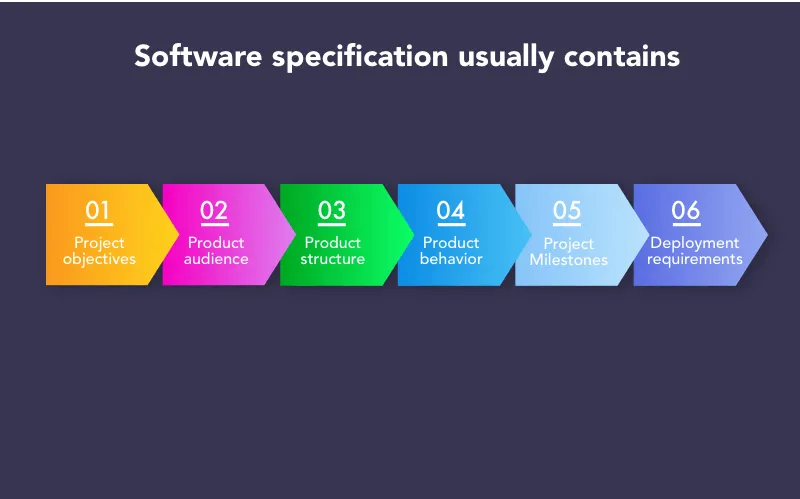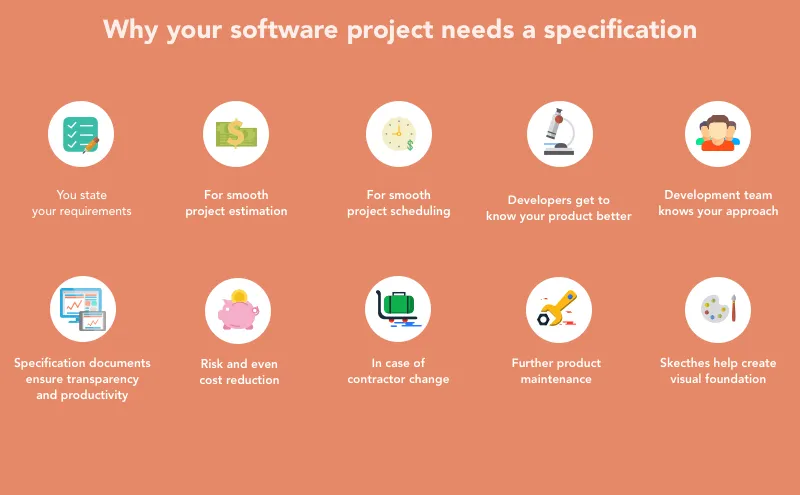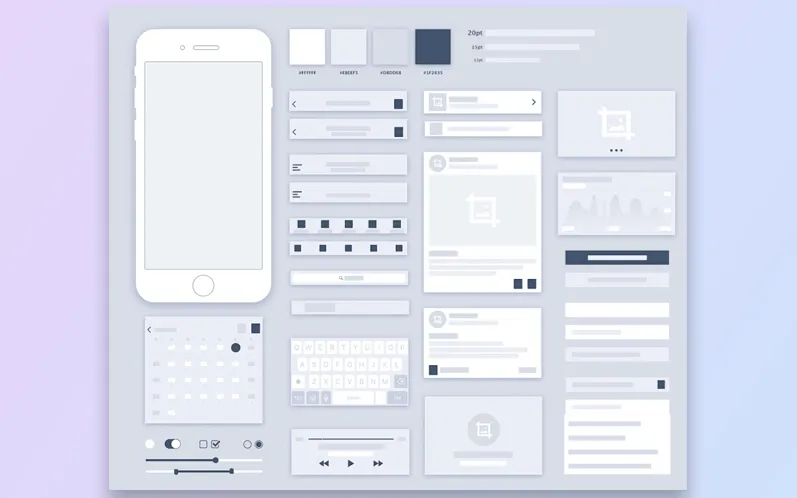Why You Need a Great Specification for Your Project
Updated 06 Jul 2023
8 Min
5729 Views
When you decide to create a mobile application or website, a lot is usually at stake. It is not enough to just discuss your requirements, come to an agreement, and expect everything to work. The success of a project hinges upon how well the development team understands your requirements and expectations. One of the most important project documents that can ensure smooth product delivery is the software specification.
You see, everybody knows they should write specs, but very few actually do.
We are sure that creating a project specification is the most proven way to eliminate unnecessary risks in software and mobile development. Let me prove it to you!
Understanding what is a software specification
According to numerous sources, a software project specification is a set of documents that describe how the final product is expected to look and perform. What is a 'good' software specification? Well, it's quite simple -- a good functional and technical specifications that has enough information to get all the things done right. That's it.
As for the content, a comprehensive specification may contain up to a hundred pages, each of them is priceless as they describe the scope of work expected to be done:
- project objectives;
- the intended product audience;
- product structure (interfaces, components, dependencies, etc);
- product behavior (description of how the components interact);
- milestones;
- deployment requirements (third-party components, runtime requirements, etc.).

What is usually there in software specification?
All in all, software specification is a complex hands-on reference for all the stakeholders of the project. It fully reflects customer's desires and requirements. On the other hand, provides structured hints and all the relevant information to the developers, QA team and management to make right decisions.
Just to clear things up, there are two types of specification I'm going to talk about -- Functional and Technical specs. Don't mix them up. Here is the what the difference is.
Functional specs provide a detailed description of how the product will perform.
Functional specification or Software design document. A detailed description of how the product will perform from the user's perspective is a functional specification. It provides a broad, general understanding of how your mobile app or website will work after everything is has been implemented. It doesn't answer the question to how exactly everything is implemented. Therefore, functional specs can be prepared by a non-technical specialist.
Technical specification describes the technical side of software product development. In a technical specification you can find:
- detailed info of the interface signatures including data types, structures, etc.;
- class models with their methods, attributes, dependencies, and associations;
- specific algorithms that any components employ, etc.
Technical specs describe the technical side of software product development.
Read more about documents you have to deal with Types of Contracts in Outsourcing: How to Make a Wise Decision
As you see, a technical specification document is much more sophisticated and focused on the technical aspect of software development than a functional spec. It's hard to imagine a non-professional creating this kind of document. How to get it done? We'll get onto that in a moment.
Why your software project needs a specification
I hope you've noticed by now that we feel strongly about creating an in-depth software project specification.
I'm about to give you 10 reasons why you should in no way neglect it.

Reasons why your project needs specs
#1 -- You state your requirements
This is the first and the most straightforward reason for you to generate a specification document. Your project has more chances of being successful if you clearly state your requirements and expectations. Preferably, in black and white.
#2 -- For smooth project estimation
It's impossible to estimate the workload and budget of the project if the product isn't fully specified. As every product is unique with it's specific features, a universal estimation template doesn't exist, unfortunately. What leads to a fair estimation is an in-depth analysis and professionally created product specification.
#3 -- For smooth project scheduling
Almost identical story to the one above -- a specification document with nailed down decisions not only helps assess the workload of the whole team and each member separately, but also consciously works out the plan, assigns the tasks, and takes control of the development workflow.
#4 -- Developers get to know your product better
Your product starts with your idea and your vision of the final result. However, software developers may have another vision based on their own experience and perception.
If you ignore this fact, you may be disappointed with the result. Sure, the earlier you notice that something is wrong, the more chances to intervene and avoid troubles. Still, I doubt that many of you want to do that. (Correct me if I'm wrong.) You don't have to keep an eye on every stage of the development process. Besides, you have a cool project manager for that.
On the other hand, it's not always a bad thing that developers to have their own vision and your product can benefit. Developers can add value to your idea, recommend the best technology or make useful suggestions in their subject area, for example, improve the user experience.
So, how do you solve this controversial issue? The key to a successful solution is a balance. And a specification brings this balance. You describe what you want to have and how you want it to work. Meanwhile, developers suggest the best options, based on their experience and skills set.
#5 -- Development team knows your approach
You may think it's insignificant and don't care what the developers have in mind. But let me try to prove to you the opposite, so that you can avail yourself of this bonus. It's in your power to warm your team up by showing your interest and care about your own product, as you have worked on your idea and put in the effort to document it. This simple step engages the development team to meet your expectations.
#6 -- To ensure transparency and productivity
Software projects based on a specification can offer seamless workflow, rational and clear communication, and as a result, boost productivity. By creating a specification document you reduce the chaos that may build up during the project. Everyone involved knows exactly what to do, as well as when and how to do it.
#7 -- Risk and even cost reduction
A detailed description of the product architecture, functionality and performance offers a seamless development process and prevents you from unnecessary frustration during project-related decisions making. What's more, a project specification helps you avoid extra investments on redevelopment or unplanned design changes. We can foresee and prevent possible risks connected with time frames, workforce, and product quality.
#8 -- Sketches help create visual foundation
Misunderstandings may occur not only during the development phase but also when the product designers are at work. Designers tend to have their vision on the software they work on. That's why sketches that usually go with a specification document can help avoid misunderstandings and keep thing moving in the same direction.

Sample of Design sketches
#9 -- Further product maintenance
Remember, your product lifecycle isn't over after deployment. A market is like a living organism, it constantly changes, new technologies appear, and you will have to respond to these changes and adapt your software. Here comes maintenance. The Product specification makes your product flexible and responsive to changes.
See if product maintenance matters in our detail article about software development process
#10 -- In case of contractor change
You may not think of it when you make a deal with a software company, but let's imagine for some reason you decide to change the contractor. By having a well-documented specification, you will not have to explain everything from the beginning.
How to get a specification for your project
Ok, what to start with? It depends on what you've got. You may have no more than an idea or you may want to create a product similar to an existing one, by adding some features. Or maybe you own a business and dream of taking it up to the next level with new software -- a mobile app or a website. Your initial reasons are important for us to offer the best suitable solution for your needs.
Afterwards comes the process of clarifying your requirements to the contractor. It may take some time for both parties to understand each other clearly.
When it comes to bespoke document creation, you have a few options.
The first option
You provide us with a ready specification. We carefully analyze it to make sure it is consistent and meets our tech expertise.
The second option
You can take your time and create the functional and technical specs yourself. It's not easy to create specs for a project that is going to succeed. The preparation of a technical specification requires the involvement of an experienced technical specialist.
As for functional specs, if you aim to create them yourself, you should put it in as many details as possible. Don't be afraid to repeat yourself or give too many details. Forgetting something is going to lead to a mess. Try to use the approach of 'zero-knowledge'. Just assume that the reader knows nothing -- explain everything, no matter how obvious it seems.
Then having the specs, we will provide you with a project manager and a technical specialist to revise your requirements and plan the architecture as well.
The third option.
We put joint effort into an elaborate win-to-win project document. You provide us with the basic information about your product. We consider your requirements and collaboratively work out a specification. All you need to do is to review the final document and confirm that the specs completely meet your requirements.
When you can do without a specification
Of course, every rule (we take creating specs as a rule!) has exceptions. You can do without specs if your project is going to take no more than one week of coding with one programmer involved. Otherwise, without a spec, you are at risk of receiving a poor result.
The Software development process has enough risks. When you neglect the specification, you expose yourself to the biggest unnecessary risk in software development. The top-level objective of the specification for your outsourced project is to communicate what you need from your development team and eventually receive want you want and save your resources.
One more thing. A successful project is one that combines creativity with a well-reasoned approach. A great project specification requires a lot of effort, but it's definitely worth it.
If you have something on your mind, get in touch with us and let's create something special together!

Evgeniy Altynpara is a CTO and member of the Forbes Councils’ community of tech professionals. He is an expert in software development and technological entrepreneurship and has 10+years of experience in digital transformation consulting in Healthcare, FinTech, Supply Chain and Logistics
Give us your impressions about this article
Give us your impressions about this article